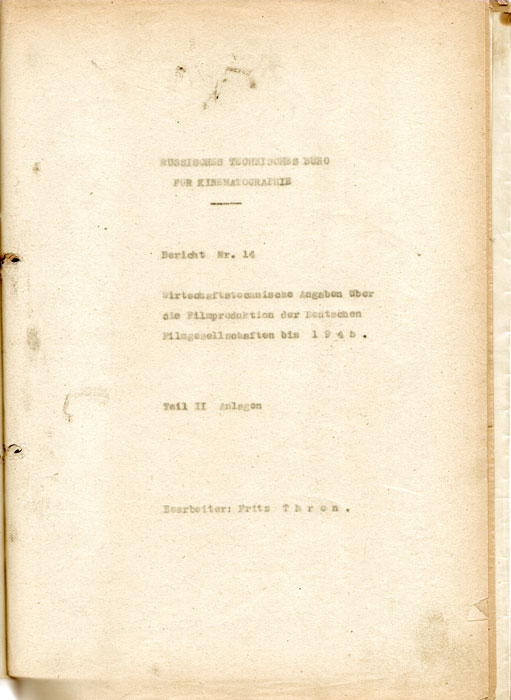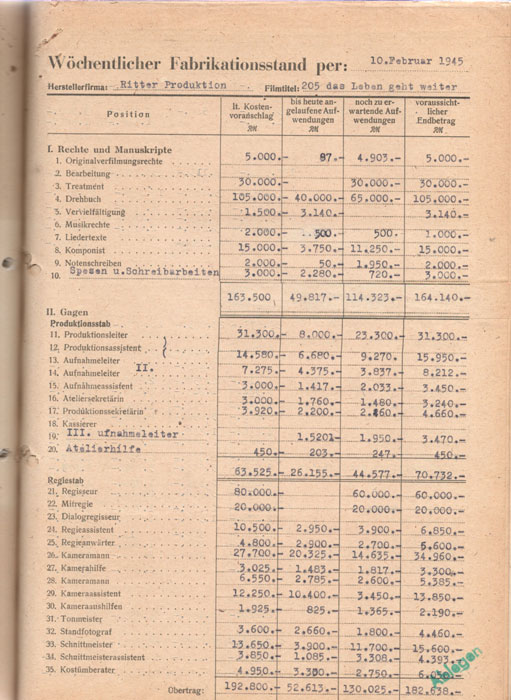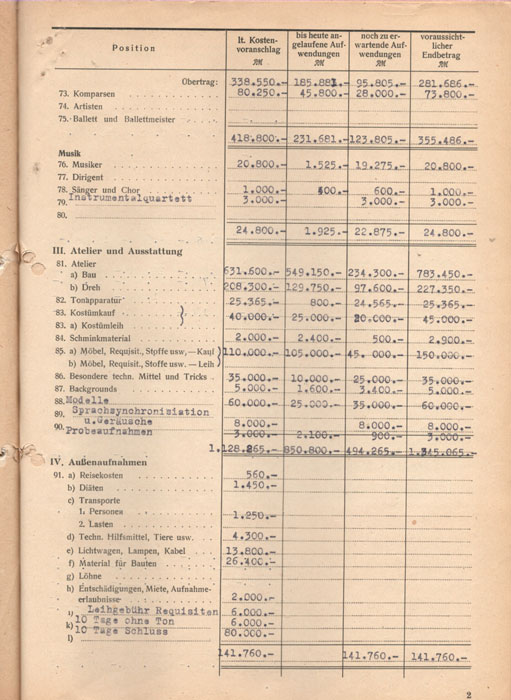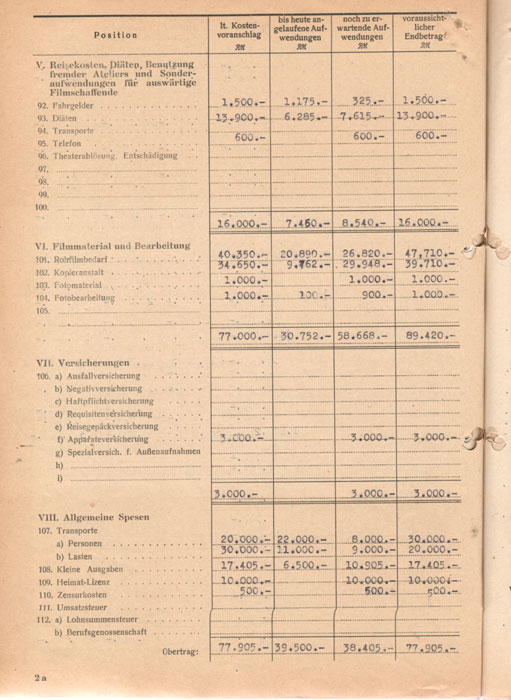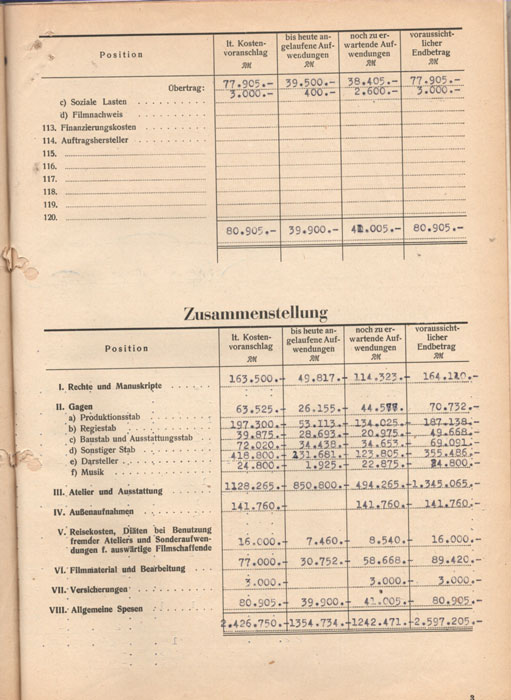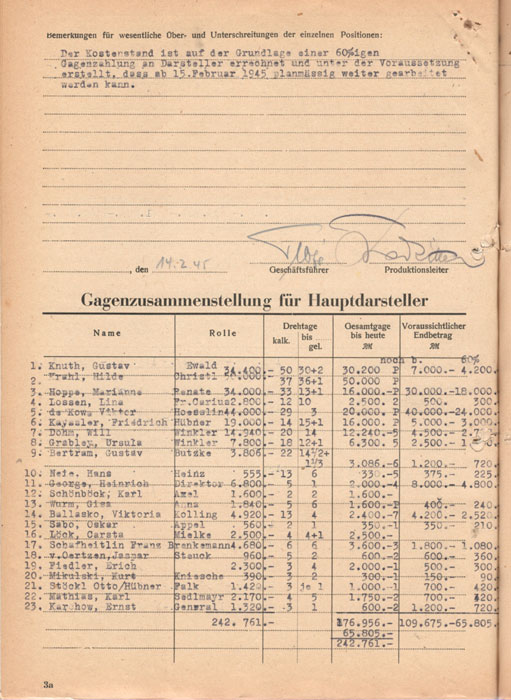- Home
- POSTER GALLERY
- ❗️BOOK & POSTER STORE❗️
- PURCHASE "HJ Quex" film ephemera HQ
- About the Posters
- The William Gillespie Collection
- Our Publishing House
- ❗️GFDN interviews author and collector William Gillespie ❗️
- Our most expensive & inexpensive finds!
- ❗️***NEW!**❗️POSTER OF THE MONTH - Blutzeugen / Raza
- ❗️NEW ❗️Film Posters – Demands on an important means of film advertising. ❗️
- In our Book + Zeitschrift Library
- ❗️ ***NEW!*** Hitler Youth Quex – A Guide for the English–speaking Reader ***NEW!*** ❗️
- ❗️***NEW!*** Table of Contents of our new HJ QUEX book❗️
- ❗️Hitler Youth Quex Guide - early praise! ❗️
- Recent loans from the Collection
- Farewell Horst Claus. (1940–2024 †)
- "Der Deutsche Film" Zeitschrift
- ❗️ ***NEW!***Reichsfilmkammer collection ❗️
- German "Tendency" Films (Tendenzfilme) in the Third Reich
- KARL RITTER
- Karl Ritter original film posers in this Collection
- "Besatzung Dora" ( † 1943)
- "The Making of The Crew of the Dora"
- Karl Ritter at the 1938 Reichsfilmkammer Congress
- INDEX -"Karl Ritter" book, 2nd edition
- Karl Ritter's Legion Condor (1939, unfinished)
- Excerpt from our "Dora" book
- ∆∆∆∆∆ High praise for our DORA book! ∆∆∆∆∆
- TABLE OF CONTENTS – "Legion Condor"
- § § § § § Early Praise for our LEGION CONDOR book! § § § § §
- ❗️"Das Leben geht weiter" and Karl Ritter ❗️
- Dateline: Ufa - April 11, 1945
- Zarah Leander Europe–wide !
- Japan Military Film and Karl Ritter
- Karl Ritter after 1945
- 1935 Film Congress
- Poster Exhibition in Berlin, March 1939
- Potsdam poster exhibition 12 April–25 August 2019
- Leni Riefenstahl's two "Olympia" Films (1938)
- "Ohm Krüger" (1941)
- Emil Jannings
- "Blutendes Deutschland" (1933)
- Hannes Stelzer ( † 1944)
- Klaus Detlef Sierck ( † 1944)
- Film stills
- Reich Film Censorship Offices
- ❗️***NEW!***The Fate of the German Film Industry in May 1945 ❗️
- Film censorship cards
- Film Archives
- Cinema advertising
- School filmstrips
- ❗️UPDATED❗️ Z F O / Ostland Film G-m-b-H
- Z F O / Herbert Jacobi estate
- ZFO / Ostland Film newspaper articles
- ❗️***NEW!*** Roter Nebel / Red Fog / Red Mist (1942/1943, ZFO) ❗️
- ZFO - Der Rückkehrer - The Returnee (1943/1944)
- The D F G production company
- D I F U
- ❗️ ***NEW!*** "Carl Peters" – Special Collection. ❗️
- "Alcazar" (1940, Genina)
- "Der 5. Juni" (1943, banned)
- Herbert Selpin and his "Titanic" (1943)
- Ein Robinson (1940, Fanck)
- "Fronttheater" (1942)
- Veit Harlan's Jud Süß and Fritz Hippler's Der Ewige Jude
- Harlan "Jud Süß" trial 1949
- Werner Krauss & JUD SÜß
- Anti-Semitic Film Posters in the Collection
- "Heimkehr" (1941)
- "Hitlerjunge Quex" (1933)
- ❗️***NEW!*** Hitlerjunge Quex in 111 Greater Berlin Cinemas ❗️
- Jürgen Ohlsen
- "S.A.Mann Brand" (1933)
- "In der roten Hölle" (Edgar Neville, 1939)
- "Helden in Spanien" (1938)
- The Spanish Civil War in Film
- Andrews Engelmann (1901 – 1992)
- Deutsche Wochenschau
- Uƒa Feldpost
- Uƒa Kulturfilm – Informationen
- " Die Tochter des Samurai" (1937, Fanck)
- Ufa 25th Anniversary
- Invitations to world premieres
- ❗️***NEW!*** Continental Films, Paris 1940–1944 ❗️
- Film Censorship in Occupied Paris 1942
- "Der Sieg des Glaubens" (1933)
- Wilhelm Althaus Estate
- Weimar Germany posters
- Ufa and the Ordensburgen
- The Gaufilmstelle in our Collection
- "Zwei Welten" (1940)
- "Capriccio" (1938) –Karl Ritter film album
- Unrealised NS Propaganda Films 1934–1945
- German Film Directors accused of "war crimes"
- Australian––themed NS feature films
- "Der Störenfried" / "The Troublemaker"
- What was new in 2014?
- What was new in 2015?
- What was new in 2016?
- What was new in 2017?
- What was new in 2018?
- What was new in 2019?
- What was new in 2020?
- What was new in 2021?
- What was new in 2022?
- What was new in 2023 ?
- What's new in 2024?
- ❗️***NEW!*** Hitler assassination attempt in Karl Ritter film cut❗️
- BESATZUNG DORA private photos
- Just discovered 1942 article on BESATZUNG DORA
- The Karl Ritter Tetralogy
- Google Analytics 2023
- Our first–ever acquisition!
- ❤️"Some of our favourite things....!"❤️
- ERRATUM for our " Hitler Youth Quex Guide"
- Trending
- Vale †
- Our Wants List / 2024 / Wunschliste
- Pop Quiz
- Unsere KARL RITTER Bücher in Deutschland liefbar!
- WHERE to buy our books right now?
- ✉️Contact
 “History is not about the facts. It is about the context and who is telling the story.” —Prof. Milton Fine.
“History is not about the facts. It is about the context and who is telling the story.” —Prof. Milton Fine.
"Who controls the past controls the future: who controls the present controls the past." –– George Orwell in his novel "1984."
"Whoever doubts the exclusive guilt of Germany for the Second World War destroys the foundation of post–war politics." –– Prof. Theodor Eschenberg, Rector, the University of Tübingen.
"If we have our own why in life, we shall get along with almost any how." – Friedrich Nietzsche
POSTER GALLERY --view
over 500 German film
original posters between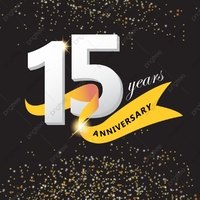
1927–1954 from
Germany and from
many Axis and Neutral countries
across Europe!
Note! Posters in the Poster Gallery are PERMANENT
acquisitions which are NOT FOR SALE!! ONLY the
posters listed in our POSTER STORE are for sale.
(They have a price and order button to use.)
Das Leben geht weiter and Karl Ritter
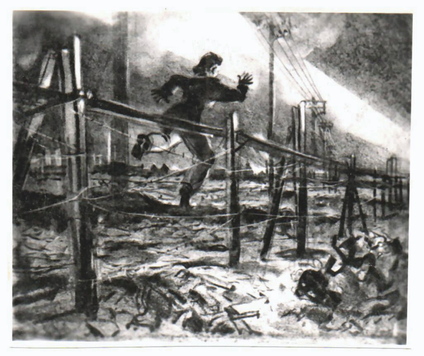
Above: One of a a handful of storyboard sketches for Das Leben geht weiter which survived. Drawn by Karl Ritter 1944. (not in our Collection.)
The propaganda film Life goes on / Das Leben geht weiter was an idea of Dr. Joseph Goebbels which in late 1943 began to take shape as a treatment, then a script, followed by many revisions and iterations. The film intended to show how the German people coped and retained their spirit through the destruction of their city and horror of their everyday life, struggling through to the promised victory. With an all-star cast, it is declared to be a film essential to the war effort, and no cost was spared to commence work on the project. The Director was Wolfgang Liebeneiner, successful with his Ich klage an euthanasia film and his two Bismarck biopics, who by this time was also Chief of Ufa film studios. He turned to Karl Ritter to be Production Head of the film, under the aegis of the management of Herstellungsgruppe Ritter.
In his book about this film, Hans-Christoph Blumenberg comments:
‘Now that even in Babelsberg you can no longer draw on the full [resources], Ritter's organizational talent is in demand. He, who prepares his films with military precision, who oversees construction planning, studio occupancy, and the use of film extras down to the last detail, is one of the few at Ufa who can carry out even the most complicated large-scale projects without a hitch.'
On August 31, 1944 Ritter received the Ufa treatment for the film Das Leben geht weiter.
The following day, Reichsminister Goebbels received a memorandum from Reichsfilmintendant Hans Hinkel regarding Ritter’s request to quit Ufa and take up service in the Luftwaffe again. The memo reads:
'Professor Liebeneiner and we do not wish to release Ritter, as he is not only a good driving force but is planned to be Production Leader in the near future, with all the preparation for tackling the next named film, Das Leben geht weiter.
For this film, moreover, his connections to the Luftwaffe will be of interest. Therefore I propose to the Minister that Ritter minimally be kept in our area until the conclusion of this film. Should I make Professor Ritter so aware? '
On September 9th, Ritter received a letter from [Reichsfilmintendant] Hans Hinkel confirming that the Propaganda Ministry had given Ufa an order to produce Das Leben geht weiter and that Ufa would be providing all possible support for it.
On September 20th Ritter commenced work on Das Leben geht weiter.
The first day of filming of Das Leben geht weiter took place on November 10th.
In late 1944, the Propaganda Ministry organized a “Film Reprise” action of nationalistic films in cinemas in conjunction with the launch of the Volkssturm. Amongst the 33 films chosen were Stukas, Verräter, Über alles in der Welt, and GPU.
On 11 December 1944 Karl Ritter was made Commander of the Babelsberg Volkssturm battalion, with ‘60 Panzerfausts and two machine guns, with scarcely any ammunition.’
On 12 March 1945 Ritter was authorized by Reichsfilmintendant Hinkel to drive from Babelsberg to Garmisch–Partenkirchen and Munich, on ‘urgent war business’ associated with the filming of Gerhard Lamprecht’s [film] Kamerad Hedwig. The authorization letter stated that ‘all Departments of the State, the Wehrmacht and the NSDAP are asked to provide the above–named every assistance.’
In the 2003 documentary film also titled Das Leben geht weiter, there is the inference that Ritter’s travel pass was obtained as an attempt on his part to flee Berlin for safer ground, stating that "Ritter never returned to Berlin." But the idea that he would flee the war is contradicted by his repeated insistences since February ’44 to being allowed to rejoin the Luftwaffe for active service at the Front, which was finally granted. * Less than a week later, on 17 March 1945 Ritter was informed that Dr. Goebbels, ‘after great consideration,’ had approved his request to quit Ufa and take up duties on the front if Ritter was successful in being placed in a military unit.
With his release from Ufa, Ritter drove to Bayreuth on March 27th and stopped–over for two hours at Haus Wahnfried to visit ‘Winni’ Wagner. He reached the Bavarian town of Oberaudorf on the 28th and visited the home of actress Suse Graf, whose few major film roles included the Ritter films Besatzung Dora and Sommernächte, and who according to grandson Dr. Michael Ritter, was a one–time girlfriend of Gottfried Ritter.
In Oberaudorf, Ritter found safe lodging for his family so that they could flee Berlin when the time came. He departed on the 29th and went to Garmisch–Partenkirchen, then on to his old domicile Munich – now almost completely destroyed by Allied bombs – arriving back in Potsdam on 31 March.
Upon his arrival back in Potsdam from Oberaudorf and Munich he found that he had been relieved of his Das Leben geht weiter duties. His last day working at Ufa was April 4th. He reported for military duty the next day, being assigned to the General Staff, Luftgau, Kommando VIII, at Wischau near Prague
All but the first two introductory paragraphs above are taken directly from: Gillespie, KARL RITTER -His Life and ‘Zeitiflms’ under National Socialism ©2012-2014. pp.49–52. All citations/footnotes from sources quoted in this text are to be found in the KARL RITTER book.
* The documentary film is based on the book by Hans-Christoph Blumenberg who sneeringly conjectured: That [i.e.Garmisch-Parteikirchen] is exactly where Professor Karl Ritter is planning to leave in mid-March. Even to him the thought of falling on the barricades of Babelsberg in a heroic struggle seems strange. -and- A Karl Ritter would never admit that his heroism left him at the last second. Blumenberg cleverly omits that Ritter not only returned to Potsdam and the Ufa studios, but then re-joined the Luftwaffe as a Major and was sent on active duty in the last ferocious five weeks of the European War. Karl Ritter then saw active service in Prague, Brno, and then Wischau. Fighting the Russians in what was then Böhmen–Mähren, Ritter was aware of the risks he faced. In his diary, he wrote: ‘It was clear to me that I could not be taken into Russian captivity, as the GPU film was no secret.’ He was captured by the Americans on 8 May and turned over to the Soviets five days later near Prague but escaped on 15 May during transport to Mährisch–Ostrau and then after a harrowing 24 day and night trek crossed the border into Austria. Ritter later recalled: ‘Captured by the Russians, fled the transport to the East and walked through forests of Bohemia, Lower and Upper Austria to Bavaria, where (I) suspected the family, displaced from Babelsberg, were found with friends in Oberaudorf.’ His memoir of his escape from Soviet captivity across merciless enemy and Partisan lines is published for the first time in the Gillespie biography. Ritter's courage as a soldier in both WWI and WWII, with both a Second and a First Iron Cross, cannot be disputed, no matter how post-war film historians would conjure otherwise.
The film reels of Das Leben geht weiter were hidden in April 1945 in the 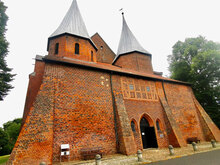 crypt of the church in Bardowick just before the arrival of British troops. The film was a Nitro print, meaning that it was highly flammable (not "safety film"). Children from the town discovered the reels and lit them up, where they sparked and erupted into flames, which entertained the children as if they were igniting fire-crackers. This story on "the last propaganda film of the Third Reich" is told in the documentary film of 2003. At right we show a recent photograph of the church in Bardowick, taken by a friend (MR), with thanks.
crypt of the church in Bardowick just before the arrival of British troops. The film was a Nitro print, meaning that it was highly flammable (not "safety film"). Children from the town discovered the reels and lit them up, where they sparked and erupted into flames, which entertained the children as if they were igniting fire-crackers. This story on "the last propaganda film of the Third Reich" is told in the documentary film of 2003. At right we show a recent photograph of the church in Bardowick, taken by a friend (MR), with thanks.
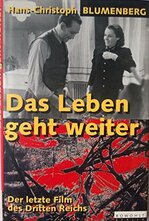
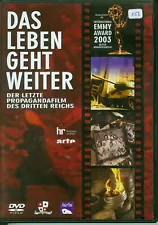
We have acquired the original Ufa film studio budget, dated 10 February 1945, found in a compilation of Ufa materials prepared for the Soviets after they overran the Babelsberg grounds in April 1945. We won this very rare Ufa bound volume of original documents from 1942–1945 in a Munich auction. The Blumenberg book states that the film budget was RM2,423 million -- an enormous sum. Herr Blumenberg must have seen earlier budget documents in the German Federal Film Archives that those we show here. The total in our budget pages is RM2,426 million with a final estimated expenditure on the film of RM2,597 million. Our budget sheets may well be the final ones for the film.
